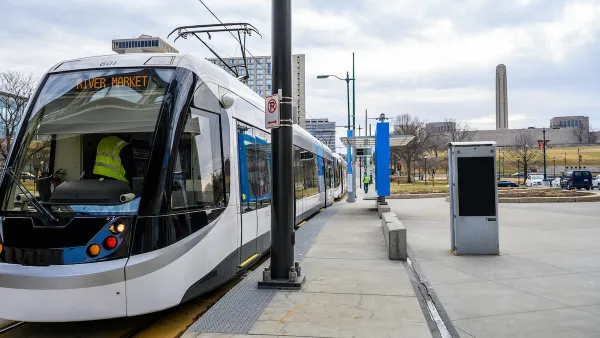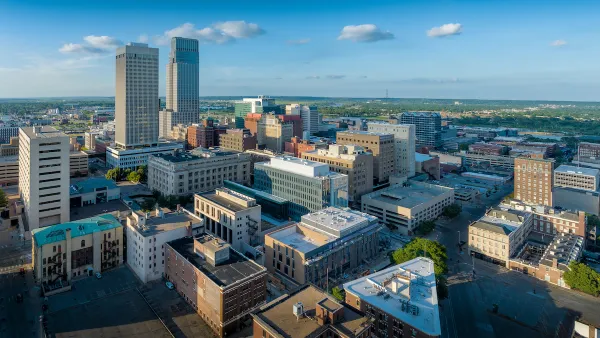I’ve confirmed that it is possible to take public transportation to the most suburban of suburban locations: the outlet mall.
I've confirmed that it is possible to take public transportation to the most suburban of suburban locations: the outlet mall. San Diego might not have the best public transportation system in the world, but it is an option here, which is a step ahead of many American cities. To get to the Carlsbad Outlets, I hopped on the San Diego Trolley, transferred to the Coaster commuter rail and then transferred again to a north county bus line. Presto! Almost two and a half hours later, I'm at the outlets (the trip typically takes 20 minutes by car, if traffic is light).
I also confirmed that I am the only person in San Diego County who would take public transit to an outlet mall on a Saturday afternoon; my bus both to and from the train station was completely empty. Now, I didn't mind the trip for a leisurely day of shopping because the drive on I-5 is a headache even without a traffic jam. But multiple transit connections would clearly be a deal breaker for anyone on a tight schedule, especially morning commuters.
Ridership is high only in cities that offer truly comprehensive transit systems – for example, subway stops in every neighborhood and trains that run often. Anyone who has traveled to European cities knows that rail-only trips are the most convenient. Add a rail-to-bus connection and things start to get a little tedious.
Because San Diego County's built environment is so sprawling and chaotic, the only possible way to reach many destinations is by car or, at best, a rail-to-bus trip with multiple connections. Should we expect any mass transit system to deliver riders to the middle of nowhere, let alone quickly and efficiently?
And that's exactly the problem. As long as we continue to build in the middle of nowhere, the car will be default mode of transportation. Take for example 4S Ranch, the pseudo New Urbanist complex located on virtual wilderness land in Rancho Bernardo, 25 miles northeast of San Diego. I guarantee that almost no one who lives in these new developments is working in Rancho Bernardo; most are commuting by freeway to San Diego. (There is currently no rail service to this area, nor should there be, considering the location and autocentric design of this suburb).
This does not mean that transit can't work well over large distances. In the early 1900's, electric rail flourished in Los Angeles and San Diego because the lines connected distinct satellite villages, with development concentrated around rail stops. LA's Pacific Electric successfully linked downtown, Hollywood, Burbank, Pasadena, Santa Monica and Long Beach – not exactly a compact area. San Diego's streetcars covered all of the main attractions, including Balboa Park, Ocean Beach, Pacific Beach and La Jolla – none of which are served by rail today.
While the City of San Diego was on the right track when it unveiled its "City of Villages" smart growth strategy in 2002, San Diego County continues to allow a suburban sprawl free-for-all. The county is now investing billions to relieve freeway congestion caused by the number of office parks, malls and poorly planned housing complexes that are randomly scattered across the landscape. Unless the two governments can work together to realize a sane growth strategy, it's hard to envision an effective county-wide transit system anytime soon.

Analysis: Cybertruck Fatality Rate Far Exceeds That of Ford Pinto
The Tesla Cybertruck was recalled seven times last year.

National Parks Layoffs Will Cause Communities to Lose Billions
Thousands of essential park workers were laid off this week, just before the busy spring break season.

Retro-silient?: America’s First “Eco-burb,” The Woodlands Turns 50
A master-planned community north of Houston offers lessons on green infrastructure and resilient design, but falls short of its founder’s lofty affordability and walkability goals.

Test News Post 1
This is a summary

Analysis: Cybertruck Fatality Rate Far Exceeds That of Ford Pinto
The Tesla Cybertruck was recalled seven times last year.

Test News Headline 46
Test for the image on the front page.
Urban Design for Planners 1: Software Tools
This six-course series explores essential urban design concepts using open source software and equips planners with the tools they need to participate fully in the urban design process.
Planning for Universal Design
Learn the tools for implementing Universal Design in planning regulations.
EMC Planning Group, Inc.
Planetizen
Planetizen
Mpact (formerly Rail~Volution)
Great Falls Development Authority, Inc.
HUDs Office of Policy Development and Research
NYU Wagner Graduate School of Public Service




























